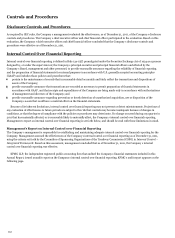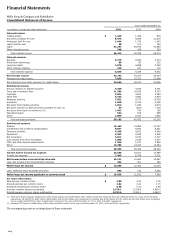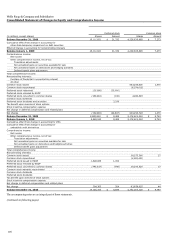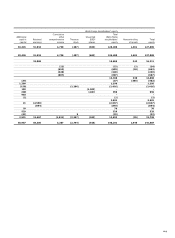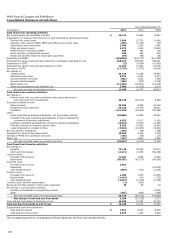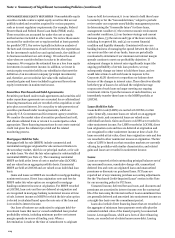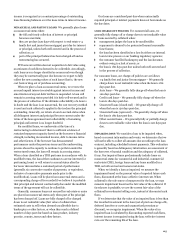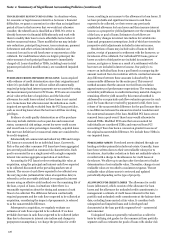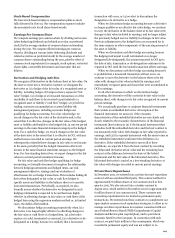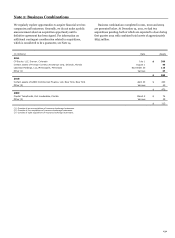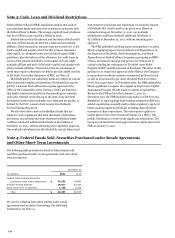Wells Fargo 2011 Annual Report Download - page 124
Download and view the complete annual report
Please find page 124 of the 2011 Wells Fargo annual report below. You can navigate through the pages in the report by either clicking on the pages listed below, or by using the keyword search tool below to find specific information within the annual report.
Note 1: Summary of Significant Accounting Policies (continued)
ASU 2011-08 provides entities with the option to perform a
qualitative assessment of goodwill to test for impairment. If,
based on qualitative reviews, a company concludes that more
likely than not a reporting unit’s fair value is less than its
carrying amount, then the company must complete quantitative
steps to determine if there is goodwill impairment. If a company
concludes otherwise, quantitative tests are not required. Our
adoption of this Update did not affect our consolidated financial
statements.
Accounting Standards with Retrospective Application
The following accounting pronouncements have been issued by
the FASB but are not yet effective:
Accounting Standards Update (ASU or Update) 2011-11,
Disclosures about Offsetting Assets and Liabilities;
ASU 2011-05, Presentation of Comprehensive Income; and
ASU 2011-12, Deferral of the Effective Date for
Amendments to the Presentation of Reclassifications of
Items Out of Accumulated Other Comprehensive Income in
Accounting Standards Update No. 2011-05.
ASU 2011-11 expands the disclosure requirements for financial
instruments and derivatives that may be offset in accordance
with enforceable master netting agreements or similar
arrangements. The disclosures are required regardless of
whether the instruments have been offset (or netted) in the
statement of financial position. Under ASU 2011-11, companies
must describe the nature of offsetting arrangements and provide
quantitative information about those agreements, including the
gross and net amounts of financial instruments that are
recognized in the statement of financial position. These changes
are effective for us in first quarter 2013 with retrospective
application. This Update will not affect our consolidated
financial results since it amends only the disclosure
requirements for offsetting financial instruments.
ASU 2011-05 eliminates the option for companies to include
the components of other comprehensive income in the statement
of changes in stockholders’ equity. This Update requires entities
to present the components of comprehensive income in either a
single statement or in two separate statements, with the
statement of other comprehensive income (OCI) immediately
following the statement of income. This Update also requires
companies to present amounts reclassified out of OCI and into
net income on the face of the statement of income. In December
2011, the FASB issued ASU 2011-12, which defers indefinitely
the requirement to present reclassification adjustments on the
statement of income. The remaining provisions are effective for
us in first quarter 2012 with retrospective application. Early
adoption is permitted. This Update will not affect our
consolidated financial results as it amends only the presentation
of comprehensive income.
Consolidation
Our consolidated financial statements include the accounts of
the Parent and our majority-owned subsidiaries and VIEs
(defined below) in which we are the primary beneficiary.
Significant intercompany accounts and transactions are
eliminated in consolidation. If we own at least 20% of an entity,
we generally account for the investment using the equity
method. If we own less than 20% of an entity, we generally carry
the investment at cost, except marketable equity securities,
which we carry at fair value with changes in fair value included
in OCI. Investments accounted for under the equity or cost
method are included in other assets.
We are a variable interest holder in certain special-purpose
entities (SPEs) in which equity investors do not have the
characteristics of a controlling financial interest or where the
entity does not have enough equity at risk to finance its activities
without additional subordinated financial support from other
parties (referred to as VIEs). Our variable interest arises from
contractual, ownership or other monetary interests in the entity,
which change with fluctuations in the fair value of the entity's
assets. We consolidate a VIE if we are the primary beneficiary,
defined as the party that that has both the power to direct the
activities that most significantly impact the VIE and a variable
interest that could potentially be significant to the VIE. A
variable interest is a contractual, ownership or other interest
that changes with changes in the fair value of the VIE’s net
assets. To determine whether or not a variable interest we hold
could potentially be significant to the VIE, we consider both
qualitative and quantitative factors regarding the nature, size
and form of our involvement with the VIE. We assess whether or
not we are the primary beneficiary of a VIE on an on-going basis.
Cash and Due From Banks
Cash and cash equivalents include cash on hand, cash items in
transit, and amounts due from the Federal Reserve Bank and
other depository institutions.
Trading Assets
Trading assets are primarily securities, including corporate debt,
U.S. government agency obligations and other securities that we
acquire for short-term appreciation or other trading purposes,
and the fair value of derivatives held for customer
accommodation purposes or risk mitigation and hedging.
Interest-only strips and other retained interests in
securitizations that can be contractually prepaid or otherwise
settled in a way that the holder would not recover substantially
all of its recorded investment are classified as trading assets.
Trading assets are carried at fair value, with realized and
unrealized gains and losses recorded in noninterest income.
Securities
SECURITIES AVAILABLE FOR SALE
Debt securities that we might
not hold until maturity and marketable equity securities are
classified as securities available for sale and reported at fair
value. Unrealized gains and losses, after applicable taxes, are
reported in cumulative OCI. Fair value measurement is based
upon quoted prices in active markets, if available. If quoted
prices in active markets are not available, fair values are
measured using independent pricing models or other model-
based valuation techniques such as the present value of future
cash flows, adjusted for the security's credit rating, prepayment
assumptions and other factors such as credit loss assumptions
122


